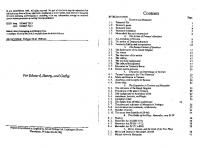On the Sentence-Question in Plautus and Terence 9781463221591
Edward Parmalee Morris uses his intimate knowledge of the syntax of Plautus to address the conventions for understanding
201 64 7MB
English Pages 116 [120] Year 2009
Recommend Papers

- Author / Uploaded
- Edward Morris
File loading please wait...
Citation preview
On the Sentence-Question in Plautus and Terence
fir
Vti £ '(
A n a l e c t a Gorgiana
299 Series Editor George Kiraz
Analecta Gorgiana is a collection of long essays and
short
monographs which are consistently cited by modern scholars but previously difficult to find because of their original appearance in obscure publications. Carefully selected by a team of scholars based on their relevance to modern scholarship, these essays can now be fully utili2ed by scholars and proudly owned by libraries.
On the Sentence-Question in Plautus and Terence
Edward Morris
gorgia* press 2009
Gorgias Press LLC, 180 Centennial Ave., Piscataway, NJ, 08854, USA www.gorgiaspress.com Copyright © 2009 by Gorgias Press LLC Originally published in All rights reserved under International and Pan-American Copyright Conventions. No part of this publication may be reproduced, stored in a retrieval system or transmitted in any form or by any means, electronic, mechanical, photocopying, recording, scanning or otherwise without the prior written permission of Gorgias Press LLC. 2009
1
ISBN 978-1-60724-561-2
ISSN 1935-6854
Extract from The American Journal of Philology, vols. 10 & 11 (1889;1890).
Printed in the LTnited States of America
AMERICAN
J O U R N A L OF
PHILOLOGY
V O L . X , 4.
WHOLE
N O . 40.
I . — O N T H E S E N T E N C E - Q U E S T I O N IN P L A U T U S AND TERENCE. First
Paper.
INTRODUCTORY.
T h e most complete discussions of the interrogative sentence in Latin are by Holtze, Synt. Prise. Script. Lat. II 236-285, and Kühner, Ausf. Gram. II 989-1024. T h e y begin with the distinction between direct and indirect questions; on this subject Becker has now said all that is needful. 1 Sentence-questions are divided by Holtze and Kühner according to the particle that introduces them, into sentences without a particle and sentences with ne, nojine, num, utrum, an. Under each head are classed the idiomatic uses, e. g. under ne, itane, ain tu, satin, sein quomodo, etc. These cover the special cases; for the commoner kinds of ne question Holtze makes no classification. Kühner employs the three-fold division into questions for information, questions expecting an affirmative answer, and questions expecting a negative answer. Questions without a particle are divided according to the presence or absence of emotion. This system of arrangement is open to serious criticism. The tests which it relies upon to distinguish emotional from unemotional questions are entirely inadequate; written language has few 1 Syntaxis Interrog. Obliq. in Studemunsl, Studien, I pp. 115-316. A s the semi-indirect questions are in form and meaning exactly like direct questions, and as I have wished to include everything which would throw light upon the nature of the interrogative sentence, I have given in my lists many questions which will also be found in Becker.
398
AMERICAN
JOURNAL
OF
PHILOLOGY.
signs for emotion. A n d even the arrangement of questions according to the answer expected is too narrow and at times actually misleading. See below the synopsis of the classification of questions according to their function, proposed by T h . Imme. T h e study of phrases with a view to discovering their functions should be the last step, not the first, in the inductive process. Further, Holtze and K ü h n e r h a v e used at the same time two systems of classification which are really distinct. Holtze, for instance, divides questions without a particle into (a) questions for information, (6) questions expressing emotion, (V) questions equivalent to an imperative, ( d ) non questions, (
![On the Sentence-Question in Plautus and Terence (Analecta Gorgiana) [1 ed.]
9781607245612, 1607245612](https://ebin.pub/img/200x200/on-the-sentence-question-in-plautus-and-terence-analecta-gorgiana-1nbsped-9781607245612-1607245612.jpg)
![Roman Comedy: Five Plays by Plautus and Terence: Menaechmi, Rudens and Truculentus by Plautus; Adelphoe and Eunuchus by Terence (Focus Classical Library) [1 ed.]
9781585103195, 9781585106233, 1585103195](https://ebin.pub/img/200x200/roman-comedy-five-plays-by-plautus-and-terence-menaechmi-rudens-and-truculentus-by-plautus-adelphoe-and-eunuchus-by-terence-focus-classical-library-1nbsped-9781585103195-9781585106233-1585103195.jpg)







